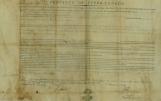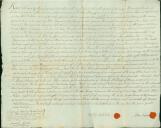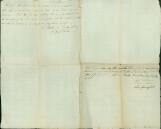1
HOW GRIMSBY AND NIAGARA GOT THEIR "ROOTS"UNITED EMPIRE LOYALISTS SETTLE IN GRIMSBY AND THE NIAGARA AREA
2
Following the end of the American Revolution, those who remained loyal to the British Crown had their property in the USA confiscated. The Loyalists were rewarded with the promise of land in British North America (Canada). In 1787, groups of United Empire Loyalists travelled to Niagara and took their oath of allegiance. One group of United Empire Loyalists travelled west to available land, settling in the area that is known today as the Town of Grimsby. The community that developed along the bank of the Forty Mile Creek was known as The Forty.3
Life was not easy for the United Empire Loyalists. Location tickets were allocated randomly and the families proceeded to their forested properties. The Loyalists were required to clear and fence five acres of land for every one hundred acres granted to them, construct a home and clear half the road in front of each lot within two years of receiving the location ticket. The settlers completed these tasks with extreme hardship, primitive tools, great determination, and faith in Great Britain. After living five years in British North America (Canada) and meeting all of the requirements of the location ticket, the Crown Grant was given to the Loyalist settler.5
Many Crown Grants were issued between 1798 and 1802. There were four hundred and ten settlers in the group that arrived in 1787, and included in this group were some of the first farmers in Grimsby. Some of these family names can still be seen on farms operating in the area Among the first settlers were John Beamer, Gershom Carpenter, William Carpenter, Elijah Chambers, Esea Chambers, Adam Green, John Green, Samuel Green, Jacob Glover, William Kitchen, Lawrence Lawrason, Levi Lewis, John Moore, Jonathan Moore, William Neil, Hendrick (Henry) William Nelles, Robert Nelles, Allen Nixon, Andrew Pettit, Charles Pettit, John Pettit, John Charles Pettit, Nathaniel Pettit, John Smith, Silas Smith, Absol Willcox and Benjamin Willcox. Most of these original farms were mixed farms, containing grain, some fruit and vegetables, and animals. These original settlers shared their land with family and sold or traded parcels of land to other settlers.8
Despite many hardships, the community began to form and, as the years passed, many farmers settled in the area with the community developing around the needs of the farmers. Grimsby and many other local towns owe their origins to farmers and their following generations who settled and worked the land.9
EARLY FARMING IN UPPER CANADAFarmers used the simple rotational practices of planting the field with grain one year and using it as a pasture the next. From 1800 to 1850, wheat was the most common crop grown in Upper Canada (Ontario). In 1837, the first cast iron plough was introduced and this allowed farmers to prepare their fields faster. After 1850 farmers experimented more and with the arrival of the railway, began to grow a greater variety of produce. Orchard farming in the Niagara region was introduced and Grimsby became known for its world famous peaches.
10
EARLY FARMING FAMILIES IN GRIMSBYTHE PETTIT FAMILY
Andrew and Sarah Pettit were one of the first families to settle at The Forty. The family tended farms and built homes, some of which are still standing. One of the homes, "The Evergreen", was built in 1820 on the foundation of an earlier log house. A portion of their land was given to their son Jonathan Robbins Pettit.
12
The Evergreen19th Century, Circa 1820
Main Street and Roberts Road, Grimsby, Ontario, Canada
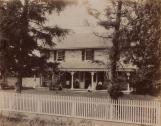 Credits:
Credits:Grimsby Museum Collection
13
Andrew's grandson Jonathan Ambrose Pettit, born in 1861 inherited the family farm and converted it from cattle and horses to berries and fruits. This farm remained in the family name until the 1920's and was sold when only girls remained in this branch of the family.14
Seal from the Pettit Farm Deed19th Century, Circa 1802
Grimsby, Ontario, Canada
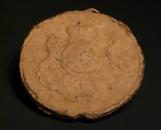 Credits:
Credits:Grimsby Museum Collection
